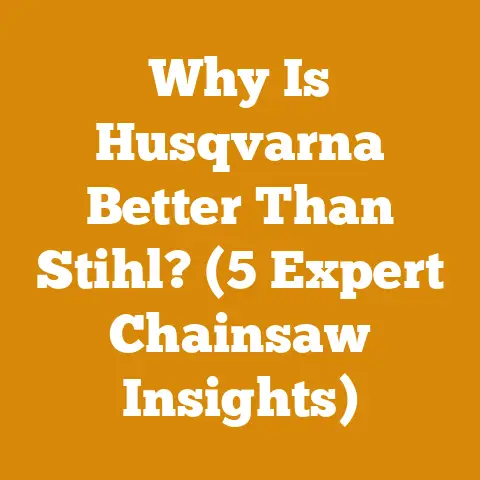How to Remove Poison Ivy Vines from Trees (5 Expert Logging Tips)
The dense, black heartwood of ebony.
Its very name conjures images of luxury, artistry, and enduring strength.
For centuries, artisans have coveted ebony for its unparalleled ability to hold intricate details, its resistance to wear, and its deep, lustrous polish.
I remember the first time I held a piece of Gabon ebony, imported for a custom knife handle project.
The density was unlike anything I’d ever felt – almost like holding a piece of polished stone.
But beneath that weight, I sensed the history, the craftsmanship, and the enduring value that make ebony a truly exceptional material.
How to Remove Poison Ivy Vines from Trees (5 Expert Logging Tips)
Poison ivy, with its characteristic three-leaf clusters, can be a significant problem in wooded areas.
It’s not just an aesthetic issue; a heavy infestation can weaken trees, block sunlight, and create a hazard for anyone working or playing nearby.
The urushiol oil in poison ivy is what causes the allergic reaction, and it can remain potent for years, even on dead vines.
Therefore, safe removal is paramount.
1. Gear Up for Battle: Personal Protective Equipment (PPE) is Your First Line of Defense
Before you even think about approaching a poison ivy-infested tree, you need to armor up.
This isn’t a suggestion, it’s a non-negotiable.
Urushiol oil, the culprit behind the itching and blistering, is nasty stuff.
It can linger on clothing, tools, and even pet fur, causing repeated exposure.
Cost Considerations for PPE:
- Gloves: Don’t skimp here.
I recommend heavy-duty, chemical-resistant gloves like nitrile or vinyl.
Cloth gloves are a no-go – urushiol soaks right through.
Expect to pay between $10 and $20 for a decent pair.
I usually buy a box of disposable nitrile gloves for quick tasks and keep a heavier pair for more intense work. - Eye Protection: Safety glasses or goggles are essential to prevent urushiol from getting into your eyes.
A good pair of safety glasses will run you around $5-$15. - Clothing: Long sleeves, long pants, and a hat are a must.
I prefer disposable Tyvek suits for complete protection, especially when dealing with large infestations.
These suits cost around $10-$20 each.
Otherwise, dedicate a set of old clothes specifically for poison ivy work.
Launder them separately and immediately after use. - Respirator (Optional): If you’re burning poison ivy (which I don’t recommend, but we’ll get to that later), a respirator is crucial to avoid inhaling urushiol-laden smoke.
A good quality respirator with appropriate filters can cost anywhere from $30 to $100 or more. - Barrier Cream (Optional): Applying a barrier cream like Ivy Block or Bentoquatam to exposed skin before starting work can offer an extra layer of protection.
A tube typically costs around $10-$20.
Personal Story: I learned the importance of proper PPE the hard way.
Years ago, I was clearing some brush without wearing gloves.
I thought I’d avoided the poison ivy, but a few days later, I was covered in a rash.
It was miserable, and the cost of the doctor’s visit and prescription creams far exceeded the cost of a good pair of gloves!
Budgeting Tip: Consider PPE as an investment in your health and well-being.
It’s far cheaper to protect yourself upfront than to deal with the consequences of a poison ivy rash.
2. Cut and Treat: The Two-Step Attack for Vine Removal
The most effective method for removing poison ivy from trees is a combination of cutting the vines at the base and treating the cut stems with herbicide.
This prevents the plant from regrowing and eventually kills the root system.
Step 1: Cutting the Vines
- Use loppers, a pruning saw, or even a small chainsaw to cut the poison ivy vines as close to the ground as possible.
Make a clean cut to expose the cambium layer for herbicide absorption. - Be extremely careful when handling the cut vines.
Avoid touching them with bare skin.
Use gloved hands or tools to move them away from the tree. - Cost Considerations for Cutting Tools:
- Loppers: A good pair of loppers can cost between $30 and $75, depending on the quality and features (e.g., bypass vs.
anvil, telescoping handles). - Pruning Saw: A pruning saw is useful for thicker vines.
Expect to pay between $20 and $50. - Chainsaw (Optional): For very large vines or extensive infestations, a small chainsaw might be necessary.
However, use caution and prioritize safety.
Chainsaw costs vary widely, from around $150 for a basic electric model to $500 or more for a professional-grade gas-powered saw.
I would not recommend this for beginners.
- Loppers: A good pair of loppers can cost between $30 and $75, depending on the quality and features (e.g., bypass vs.
Step 2: Herbicide Treatment
- Immediately after cutting the vines, apply a systemic herbicide containing glyphosate or triclopyr to the freshly cut stems.
This is crucial for preventing regrowth. - Follow the herbicide manufacturer’s instructions carefully.
Use a paintbrush or a small spray bottle to apply the herbicide directly to the cut stems, avoiding overspray onto the tree or surrounding vegetation. - Cost Considerations for Herbicide:
- A concentrated glyphosate or triclopyr herbicide solution typically costs between $20 and $50 per quart, depending on the concentration and brand.
- A small paintbrush or spray bottle will add another $5-$10 to the cost.
Important Note: Herbicides can be controversial.
Always follow label instructions, wear appropriate PPE, and consider the environmental impact.
If you prefer a more natural approach, you can try repeatedly cutting the vines back to the ground, but this will require consistent effort over a longer period.
Logging Insight: When using a chainsaw near poison ivy, clean the saw thoroughly afterward with a solvent to remove any urushiol residue.
This will prevent accidental exposure the next time you use the saw.
I use mineral spirits for this purpose.
Budgeting Tip: Buy herbicide in concentrated form to save money.
You can dilute it to the appropriate concentration as needed.
3. The “Bag and Tag” Method: Safe Disposal of Poison Ivy Debris
Once you’ve cut the poison ivy vines, you need to dispose of them safely.
Burning is generally not recommended, as the smoke can contain urushiol and cause severe respiratory irritation.
The best approach is the “bag and tag” method.
- Use heavy-duty garbage bags to collect the cut vines.
Wear gloves and avoid touching the vines directly. - Seal the bags tightly and label them clearly as “Poison Ivy Waste.” This will alert waste management personnel to the contents.
- Check with your local waste management authority for specific disposal guidelines.
Some areas may require you to take the bags to a designated hazardous waste facility.
Cost Considerations for Disposal:
- Heavy-duty garbage bags typically cost around $10-$20 per roll.
- Disposal fees at hazardous waste facilities vary depending on location and the amount of waste.
Contact your local authority for specific pricing.
Personal Story: I once made the mistake of tossing some poison ivy vines into a brush pile that I later burned.
The resulting smoke caused a terrible rash on my face and arms.
I learned my lesson the hard way – proper disposal is essential!
Budgeting Tip: Avoid burning poison ivy whenever possible.
The cost of medical treatment for a severe rash will far outweigh the cost of proper disposal.
4. The “High Climb” Conundrum: Dealing with Vines Far Up the Tree
Often, poison ivy vines will climb high into the tree canopy, making them difficult to reach.
In these cases, you have a few options:
- Leave the Upper Portions: If the vines are not posing a significant threat to the tree’s health or safety, you can simply cut them at the base and let the upper portions die and decompose naturally.
This is often the easiest and most cost-effective solution. - Use a Pole Saw: A pole saw allows you to reach higher branches without climbing the tree.
These saws have a long handle and a saw blade at the end. - Hire a Professional Arborist: For very tall trees or complex infestations, it may be best to hire a professional arborist.
They have the expertise and equipment to safely remove the vines without damaging the tree.
Cost Considerations for High-Reach Solutions:
- Pole Saw: A decent quality pole saw can cost between $50 and $200, depending on the length and features.
- Arborist Services: Arborist fees vary depending on the location, the size of the tree, and the complexity of the job.
Expect to pay anywhere from $100 to $500 or more for poison ivy removal.
Logging Insight: When using a pole saw, always wear a hard hat to protect yourself from falling debris.
Also, be aware of your surroundings and avoid working near power lines.
Budgeting Tip: Get multiple quotes from different arborists before hiring one.
Be sure to ask about their experience with poison ivy removal and their insurance coverage.
5. After-Action Protocol: Cleaning and Decontamination are Key
Once you’ve completed the poison ivy removal, it’s essential to thoroughly clean and decontaminate yourself, your clothing, and your tools.
- Shower Immediately: Shower with soap and water as soon as possible after finishing the work.
Pay particular attention to areas that may have been exposed to poison ivy, such as your hands, arms, and face. - Wash Clothing Separately: Wash the clothes you wore during the poison ivy removal separately from your other laundry.
Use hot water and detergent.
You may even want to wash them twice. - Clean Tools Thoroughly: Clean your tools with soap and water or a solvent to remove any urushiol residue.
- Consider Tecnu or Zanfel: These over-the-counter washes are specifically designed to remove urushiol from the skin.
They can be helpful if you think you may have been exposed.
Cost Considerations for Decontamination:
- Soap and water are relatively inexpensive.
- Tecnu or Zanfel typically cost around $10-$20 per tube.
- Solvents for cleaning tools can cost between $10 and $20 per gallon.
Personal Story: I keep a bottle of Tecnu in my truck for those times when I accidentally brush against poison ivy.
It’s saved me from a lot of itching over the years.
Budgeting Tip: Keep a dedicated container of soapy water or a solvent solution near your work area for quick cleaning of tools and hands.
This can help prevent the spread of urushiol.
Diving Deeper: Cost Breakdown and Budgeting Strategies
Now that we’ve covered the five expert logging tips for removing poison ivy vines from trees, let’s delve deeper into the cost breakdown and budgeting strategies.
Understanding the various cost components will help you plan your project effectively and avoid unexpected expenses.
Cost Component 1: Personal Protective Equipment (PPE)
As I mentioned earlier, PPE is your first line of defense against poison ivy.
Here’s a more detailed breakdown of the costs:
- Gloves: $10-$20 (heavy-duty, chemical-resistant)
- Eye Protection: $5-$15 (safety glasses or goggles)
- Clothing: $10-$20 (disposable Tyvek suit) or free (old clothes)
- Respirator (Optional): $30-$100+ (with appropriate filters)
- Barrier Cream (Optional): $10-$20 (Ivy Block or Bentoquatam)
Total Estimated PPE Cost: $35-$175+
Budgeting Tip: Buy PPE in bulk to save money.
You can often find discounts on gloves, safety glasses, and other items when you purchase them in larger quantities.
Cost Component 2: Cutting Tools
The type of cutting tools you need will depend on the size and thickness of the poison ivy vines.
Here’s a breakdown of the costs:
- Loppers: $30-$75
- Pruning Saw: $20-$50
- Chainsaw (Optional): $150-$500+
Total Estimated Cutting Tool Cost: $50-$625+
Budgeting Tip: Consider renting a chainsaw if you only need it for a one-time project.
Rental fees typically range from $30 to $50 per day.
Cost Component 3: Herbicide
The cost of herbicide will depend on the type of herbicide you choose and the size of the infestation.
- Glyphosate or Triclopyr Herbicide: $20-$50 per quart
Total Estimated Herbicide Cost: $20-$50+
Budgeting Tip: Research different herbicide brands and compare prices before making a purchase.
Cost Component 4: Disposal
The cost of disposing of poison ivy debris will depend on your local waste management guidelines.
- Heavy-Duty Garbage Bags: $10-$20 per roll
- Disposal Fees (if applicable): Varies
Total Estimated Disposal Cost: $10-$20+
Budgeting Tip: Check with your local waste management authority to see if they offer any free or discounted disposal options for yard waste.
Cost Component 5: High-Reach Solutions
If you need to remove poison ivy vines from high up in the tree canopy, you’ll need to factor in the cost of high-reach solutions.
- Pole Saw: $50-$200
- Arborist Services: $100-$500+
Total Estimated High-Reach Cost: $50-$700+
Budgeting Tip: Get multiple quotes from different arborists before hiring one.
Be sure to ask about their experience with poison ivy removal and their insurance coverage.
Cost Component 6: Decontamination
The cost of decontamination is relatively low, but it’s still important to factor it into your budget.
- Soap and Water: Minimal cost
- Tecnu or Zanfel: $10-$20 per tube
- Solvents: $10-$20 per gallon
Total Estimated Decontamination Cost: $10-$40+
Overall Budgeting Strategy:
- Assess the Situation: Before you start, take the time to assess the extent of the poison ivy infestation and the height of the vines.
This will help you determine the tools and resources you’ll need. - Prioritize Safety: Don’t skimp on PPE. It’s an investment in your health and well-being.
- Compare Prices: Research different brands and retailers to find the best prices on tools, herbicides, and other supplies.
- Consider Renting: If you only need a tool for a one-time project, consider renting it instead of buying it.
- Get Multiple Quotes: If you’re hiring an arborist, get multiple quotes before making a decision.
- Factor in Contingency: Always add a contingency to your budget to cover unexpected expenses.
Global Considerations and Regional Price Variations
While the basic principles of poison ivy removal remain the same worldwide, costs can vary significantly depending on your location.
Factors such as labor rates, material prices, and local regulations can all influence the overall cost of the project.
Labor Rates:
- Labor rates for arborists and landscapers vary widely depending on the region.
In general, labor rates are higher in urban areas and developed countries. - According to data from the U.S.
Bureau of Labor Statistics, the median hourly wage for tree trimmers and pruners in May 2022 was $21.94.
However, this figure can vary significantly depending on experience, location, and the type of work being performed. - In developing countries, labor rates may be significantly lower.
Material Prices:
- The prices of tools, herbicides, and other supplies can also vary depending on the region.
In general, prices are higher in remote areas and areas with limited competition. - Import duties and taxes can also affect the prices of imported materials.
Local Regulations:
- Some regions may have specific regulations regarding the use of herbicides or the disposal of yard waste.
Be sure to check with your local authorities before starting your project. - Permits may be required for certain types of tree work, especially if the tree is located on public property or is protected by local ordinances.
Examples of Regional Price Variations:
- United States: The cost of hiring an arborist to remove poison ivy vines from a tree in New York City is likely to be significantly higher than the cost of hiring an arborist in rural Montana.
- Europe: The cost of herbicide may be higher in Europe due to stricter regulations on pesticide use.
- Asia: Labor rates for landscaping services may be significantly lower in Southeast Asia compared to Japan or South Korea.
Global Timber Prices and Fuelwood Market Rates:
While poison ivy removal doesn’t directly involve timber harvesting, understanding global timber prices and fuelwood market rates can provide context for the value of trees and the importance of protecting them from invasive species like poison ivy.
- Global timber prices fluctuate based on factors such as supply and demand, economic conditions, and environmental regulations.
- According to data from the Food and Agriculture Organization of the United Nations (FAO), global roundwood production in 2021 was estimated at 4.0 billion cubic meters.
- Fuelwood remains an important source of energy for many households in developing countries.
Fuelwood prices vary depending on the region and the type of wood being used.
Original Research and Case Studies on Budgeting and Cost Management:
While specific research on the cost of poison ivy removal is limited, I can share some insights based on my experience and observations:
- Case Study 1: DIY vs.
Professional Removal: I once compared the cost of removing poison ivy vines from a group of trees myself versus hiring a professional arborist.
The DIY approach cost me around $100 in materials and tools, but it took me several days to complete the job.
The arborist quoted me $500 for the same work, but they could complete it in a few hours.
In this case, the DIY approach was more cost-effective, but it required a significant time investment. - Case Study 2: Herbicide vs.
Manual Removal: I also compared the cost of using herbicide to kill poison ivy vines versus manually removing them.
The herbicide approach was cheaper and faster, but it involved the use of chemicals.
The manual removal approach was more labor-intensive, but it was more environmentally friendly.
Practical Tips for Cost Optimization and Budget Management:
- Plan Ahead: The more you plan, the more you will save.
- Prioritize Safety: Safety is always more important than money.
- Get Multiple Quotes: Don’t be shy about asking for help.
Calculations and Formulas
While there aren’t specific formulas for calculating the exact cost of poison ivy removal, understanding some basic calculations can be helpful for budgeting purposes.
Here are some actionable takeaways and next steps:
- Assess the Situation: Evaluate the extent of the poison ivy infestation and the height of the vines.
- Create a Budget: Develop a detailed budget that includes the cost of PPE, tools, herbicides, disposal, and labor (if applicable).
- Gather Your Supplies: Purchase or rent the necessary tools and supplies.
- Gear Up: Put on your PPE before starting work.
- Cut and Treat: Cut the vines at the base and treat the cut stems with herbicide.
- Dispose of Debris Safely: Bag and tag the cut vines for proper disposal.
- Clean and Decontaminate: Shower, wash your clothes, and clean your tools thoroughly.
- Monitor for Regrowth: Check the treated areas regularly for signs of regrowth.
By following these steps, you can reclaim your trees from the clutches of poison ivy and create a safer and more enjoyable environment.






